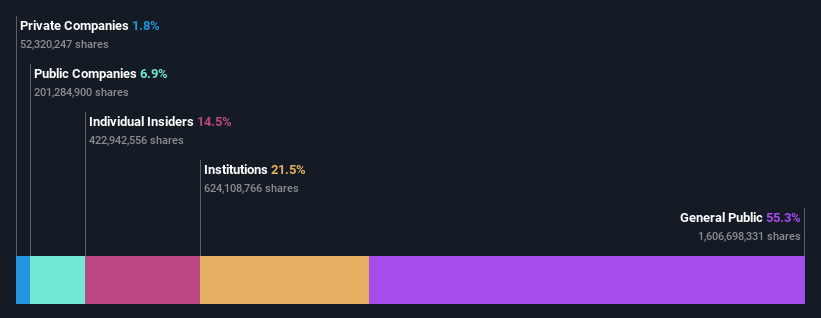- Australia
- /
- Oil and Gas
- /
- ASX:TBN
Retail investors who hold 55% of Tamboran Resources Corporation (ASX:TBN) gained 12%, institutions profited as well

Key Insights
- The considerable ownership by retail investors in Tamboran Resources indicates that they collectively have a greater say in management and business strategy
- The top 22 shareholders own 45% of the company
- 15% of Tamboran Resources is held by insiders
A look at the shareholders of Tamboran Resources Corporation (ASX:TBN) can tell us which group is most powerful. With 55% stake, retail investors possess the maximum shares in the company. Put another way, the group faces the maximum upside potential (or downside risk).
Retail investors gained the most after market cap touched AU$422m last week, while institutions who own 21% also benefitted.
Let's delve deeper into each type of owner of Tamboran Resources, beginning with the chart below.
View our latest analysis for Tamboran Resources

What Does The Institutional Ownership Tell Us About Tamboran Resources?
Institutional investors commonly compare their own returns to the returns of a commonly followed index. So they generally do consider buying larger companies that are included in the relevant benchmark index.
Tamboran Resources already has institutions on the share registry. Indeed, they own a respectable stake in the company. This suggests some credibility amongst professional investors. But we can't rely on that fact alone since institutions make bad investments sometimes, just like everyone does. When multiple institutions own a stock, there's always a risk that they are in a 'crowded trade'. When such a trade goes wrong, multiple parties may compete to sell stock fast. This risk is higher in a company without a history of growth. You can see Tamboran Resources' historic earnings and revenue below, but keep in mind there's always more to the story.

Tamboran Resources is not owned by hedge funds. Bryan Sheffield is currently the largest shareholder, with 9.3% of shares outstanding. The second and third largest shareholders are Teachers Insurance and Annuity Association-College Retirement Equities Fund and Nuveen, LLC, with an equal amount of shares to their name at 7.5%.
On studying our ownership data, we found that 22 of the top shareholders collectively own less than 50% of the share register, implying that no single individual has a majority interest.
While studying institutional ownership for a company can add value to your research, it is also a good practice to research analyst recommendations to get a deeper understand of a stock's expected performance. Quite a few analysts cover the stock, so you could look into forecast growth quite easily.
Insider Ownership Of Tamboran Resources
The definition of company insiders can be subjective and does vary between jurisdictions. Our data reflects individual insiders, capturing board members at the very least. Company management run the business, but the CEO will answer to the board, even if he or she is a member of it.
I generally consider insider ownership to be a good thing. However, on some occasions it makes it more difficult for other shareholders to hold the board accountable for decisions.
It seems insiders own a significant proportion of Tamboran Resources Corporation. Insiders own AU$61m worth of shares in the AU$422m company. This may suggest that the founders still own a lot of shares. You can click here to see if they have been buying or selling.
General Public Ownership
The general public, who are usually individual investors, hold a substantial 55% stake in Tamboran Resources, suggesting it is a fairly popular stock. This size of ownership gives investors from the general public some collective power. They can and probably do influence decisions on executive compensation, dividend policies and proposed business acquisitions.
Public Company Ownership
We can see that public companies hold 6.9% of the Tamboran Resources shares on issue. This may be a strategic interest and the two companies may have related business interests. It could be that they have de-merged. This holding is probably worth investigating further.
Next Steps:
It's always worth thinking about the different groups who own shares in a company. But to understand Tamboran Resources better, we need to consider many other factors. Case in point: We've spotted 4 warning signs for Tamboran Resources you should be aware of, and 2 of them can't be ignored.
If you would prefer discover what analysts are predicting in terms of future growth, do not miss this free report on analyst forecasts.
NB: Figures in this article are calculated using data from the last twelve months, which refer to the 12-month period ending on the last date of the month the financial statement is dated. This may not be consistent with full year annual report figures.
Valuation is complex, but we're here to simplify it.
Discover if Tamboran Resources might be undervalued or overvalued with our detailed analysis, featuring fair value estimates, potential risks, dividends, insider trades, and its financial condition.
Access Free AnalysisHave feedback on this article? Concerned about the content? Get in touch with us directly. Alternatively, email editorial-team (at) simplywallst.com.
This article by Simply Wall St is general in nature. We provide commentary based on historical data and analyst forecasts only using an unbiased methodology and our articles are not intended to be financial advice. It does not constitute a recommendation to buy or sell any stock, and does not take account of your objectives, or your financial situation. We aim to bring you long-term focused analysis driven by fundamental data. Note that our analysis may not factor in the latest price-sensitive company announcements or qualitative material. Simply Wall St has no position in any stocks mentioned.
About ASX:TBN
Tamboran Resources
A natural gas company, focuses on developing unconventional gas resources in the northern territory of Australia.
Excellent balance sheet slight.


